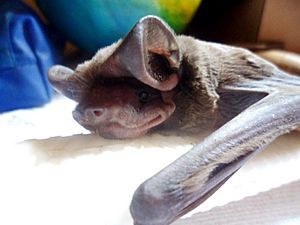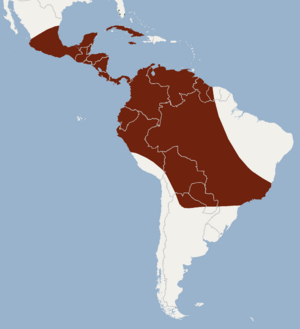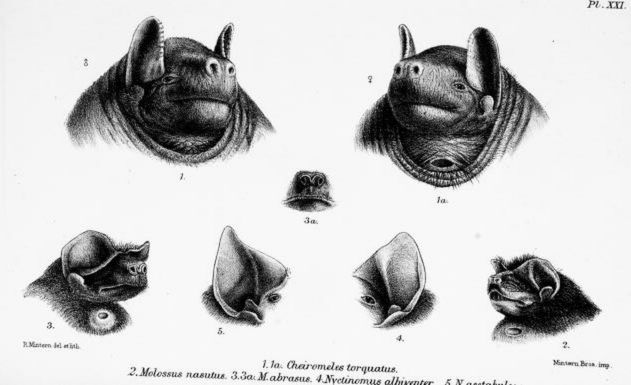Wagner's bonneted bat facts for kids
Quick facts for kids Wagner's bonneted bat |
|
|---|---|
 |
|
| Conservation status | |
| Scientific classification | |
| Genus: |
Eumops
|
| Species: |
glaucinus
|
 |
|
| Synonyms | |
|
Dysopes glaucinus |
|
Wagner's bonneted bat or Wagner's mastiff bat (Eumops glaucinus) is a type of bat that belongs to the family Molossidae. You can find this bat in many parts of the Americas. It lives from Argentina and Peru in the south, all the way north to Mexico and Cuba. There is a similar bat in Florida in the United States. Scientists now know that this bat, called the Florida bonneted bat (E. floridanus), is a separate species.
Contents
What Does This Bat Look Like?
Wagner's bonneted bat is a medium-sized mastiff bat. Its exact size can change depending on where it lives. These bats are usually about 24 or 25 centimeters (about 9 to 10 inches) long. They weigh between 30 and 47 grams (about 1 to 1.6 ounces). Pregnant females can sometimes be heavier. Male bats are generally a bit bigger than females.
This bat has short, shiny fur. The hairs are two colors, being lighter at the bottom. The overall color of their fur can be black, brown, grayish, or a cinnamon color. Their belly fur is usually duller and lighter.
The bat has a long nose. It does not have a leaf-shaped nose part or a sticking-out upper lip. However, it does have a small ridge above its eye. Its ears are about 2 centimeters (less than an inch) long. They are wider than they are long. The ears are joined together, which gives them a "bonnet" shape, like a hat.
The wingspan of this bat is about 41 to 47 centimeters (about 16 to 18.5 inches). Their wings are narrow, just like other mastiff bats. These narrow wings help them fly fast and for long distances. They are especially good at flying in open spaces.
This bat also has a musky smell. Male bats have a special gland on their throat and chest. Scientists are not sure what this gland is for. It might be used to mark females or their territory.
Where Do These Bats Live?
This bat is often found in subtropical and tropical forests. These are warm areas with lots of trees. However, these bats are also often seen living in cities and towns. They seem to like the warmth of metal roofs. You can also find them in deserts, swamps, and scrubland (areas with small trees and bushes).
Wagner's bonneted bats usually rest, or roost, in tree canopies. They also roost in holes in tree trunks. This includes old nests made by woodpeckers. They have been seen roosting in different types of trees. These include royal palm trees, degame trees, gumbo-limbo trees, and Cuban palm trees. They have been found living at high places, up to 2,750 meters (about 9,000 feet) above sea level.
Sometimes, this bat lives near other types of bats. These can include the velvety free-tailed bat (Molossus molossus), the broad-eared bat (Nyctinomops laticaudatus), the little goblin bat (Mormopterus minutus), and Pallas's long-tongued bat (Glossophaga soricina).
What Do These Bats Do?
Wagner's bonneted bats live in small groups. These groups often have both male and female bats. Sometimes, one male lives with a group of females, which is called a harem. These bats are nocturnal, meaning they are active at night.
They eat insects. Their diet includes beetles, flies, bugs, orthopterans (like grasshoppers), and moths. Scientists have even fed them raw ground beef with vitamins when keeping them in captivity.
When this bat feels threatened, it usually does not try to run away. Instead, it makes a very loud, high-pitched scream. It also makes this loud sound when it is flying at night.
This species flies high in the air. It rarely flies close to the ground. It can also take off from flat surfaces. It flies very fast, usually in a straight line. As it flies, it uses echolocation to find insects. This means it sends out sounds and listens for the echoes to locate its prey. It then catches the insects while flying, a behavior called hawking.
Reproduction and Life Cycle
These bats can have babies all year round in some areas. Most female bats give birth to one baby at a time.
How Old Is This Bat Species?
The first signs of E. glaucinus in the fossil record date back to the Pliocene epoch. This was about 3.3 million years ago.
See also
 In Spanish: Murciélago de sombrerete blanquecino para niños
In Spanish: Murciélago de sombrerete blanquecino para niños



